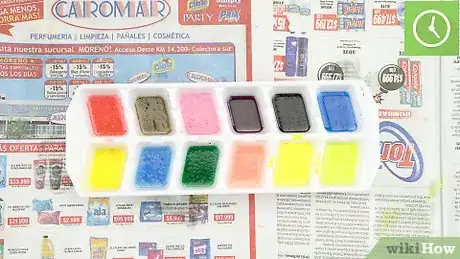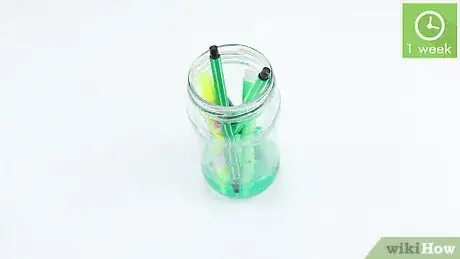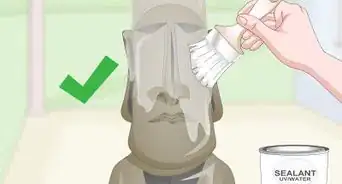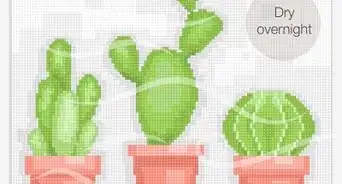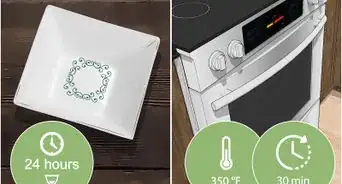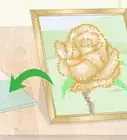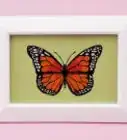This article was co-authored by wikiHow Staff. Our trained team of editors and researchers validate articles for accuracy and comprehensiveness. wikiHow's Content Management Team carefully monitors the work from our editorial staff to ensure that each article is backed by trusted research and meets our high quality standards.
There are 8 references cited in this article, which can be found at the bottom of the page.
The wikiHow Video Team also followed the article's instructions and verified that they work.
This article has been viewed 151,484 times.
Learn more...
If your children love to paint, but love putting paint in their mouths even more, then a nontoxic watercolor paint recipe may be just what you need. If your child is old enough to know better, but you are still worried about them using toxic paints, you can make homemade watercolor paints using nontoxic art supplies, such as tempera paint.
Steps
Making Pan Watercolor Paint
-
1Mix 2 parts baking soda with 1 part white vinegar. Pour 4 tablespoons (45 g) of baking soda into a measuring cup. Add 2 tablespoons (30 mL) of white vinegar. Give the mixture a stir, then let it finish fizzing.[1]
- Use a large measuring cup so that the mixture doesn't overflow. If you don't have a large measuring cup, use a large bowl instead.
- If you can't find baking soda, search for "bicarbonate soda." Do not use baking powder.
-
2Stir in some light corn syrup and cornstarch. Add in 1/2 teaspoon of light corn syrup and 2 tablespoons (15 g) of cornstarch. Stir everything together with a spoon or craft stick until the cornstarch dissolves. The mixture will be very thick at this point, which is normal.[2]
- If you can't find light corn syrup, you can use golden corn syrup instead. If you can't find either, search for Karo syrup.
- If you can't find cornstarch, search for cornflour instead. Don't use corn meal.
Advertisement -
3Pour the mixture into a muffin tin or an ice cube tray. You'll have enough mixture to fill 6 muffin wells halfway, or 12 muffin wells a quarter of the way. Ice cube trays will vary depending on the size of the wells; expect to fill anywhere between 1 and 2 trays.[3]
- The mixture may solidify as you pour it. If that happens, simply stir it back up again. You can also just scoop it out with a spoon.
-
4Stir some food coloring into each well. Use a toothpick to add 6 drops of gel food coloring into each well. Stir the food coloring into the mixture with a clean toothpick or craft stick for each color. Keep stirring until the color is even and no streaks remain.[4]
- If you can't find gel food coloring, use 20 drops of liquid food coloring for each well instead.[5]
- Use 1 color for each well; you can use the same color for multiple wells.
- If the paint becomes too runny, stir in a pinch of cornstarch or corn flour.
- Don't be afraid to mix 2 colors together to create new ones.
-
5Leave the paint to dry for several days. This can take as little as 2 days to as long as 1 week. Some paints never completely dry and maintain a gummy texture. If you are in a hurry, however, you can leave the paint in a warm, dry place (i.e. near a fireplace) for 24 hours.[6]
-
6Use the paint just like you would other pan watercolor paints. Fill a cup with water. Dip a watercolor brush into the water, then use it to get your paint wet. Use the brush and paint to create beautiful works of art.
- Store the paint in a cool, dry area. Keep in mind that it may eventually go bad. If it starts to look or smell strange, throw it out.
Making Liquid Watercolor Paint
-
1Pour a packet of unsweetened powdered drink mix into a cup. Get a packet of unsweetened powdered drink mix, such as Kool-Aid. Tear it open, and pour it into a cup. The color of your paint will depend on the flavor that you chose. Look at the color of the package to get an idea of the paint color.[7]
- Do not use sweetened powdered drink mix or Jello. The sugar will make the paint sticky.
- Be aware that some flavors do not come out true to color. For example, may "grape" flavors turn gray instead of blue or purple![8]
- This method is great for young children. The paint is edible, although it probably won't taste very good due to the fact that you are using unsweetened drink mix.
-
2Stir in 1 tablespoon (15 milliliters) of water. This should for be enough for both large and small packets of powdered drink mix. Use less water if you want the color to be darker, and more water if you want it to be lighter.[9]
- This may seem like a tiny amount of water, but it is all you need. After all, you are making paint, not juice!
-
3Repeat the process to make more colors. Again, you will need about 1 tablespoon (15 milliliters) of water for each color that you are mixing. Once you have made all your colors, you can pour them into little paint cups, small jars, or even an ice cube tray!
-
4Pour the point into a more convenient container, if desired. You can use this paint straight from the cup, but if you want to save it for later, it would be a good idea to pour it into a small jar(s) instead.
-
5Use the paint like regular liquid watercolor. This paint is ready to use, so you don't have to add more water to it to make it wet. Dip your paintbrush into the paint, and give it a try! Be aware that this paint does stain. Protect your work surface and wear an old shirt or an artist's smock.[10]
- Use camelhair watercolor brushes with this. Don't use coarse boar bristle brushes.
- Scratch the paint after it dries to help it release its fragrance!
- Discard any leftover paint, or store it in a little jar for the next day.
Making Other Types of Watercolor Paint
-
1Mix water with food coloring for something quick and easy. Pour about 1/4 cup (60 mL) water into a small container. Add 1 to 2 drops of liquid food coloring, then give it a stir. Try the paint out on paper. If it is not dark enough, add more food coloring.
- You can use gel food coloring, but you will need to stir it longer.
- The exact amount of water you use depends on how much paint you want to make.
-
2Dissolve pan watercolor paint in water to make liquid watercolor paint. Fill a glass jar with 1/2 cup (120 mL) of hot water. Pry a pan of solid, nontoxic watercolor paint out of its tray, and plop it into the water. Wait a few minutes, then give the paint a stir. Add up to 1/2 cup (120 mL) of water if the color is too dark.[11]
- The paint may look cloudy at first, but it will clear up.
- Make sure that the paint you are using is nontoxic. Most children's watercolor paints will be nontoxic.
-
3Dilute nontoxic tempera paint with water to make liquid watercolor paint. Find a bottle of nontoxic tempera paint. Squirt a dollop of the paint into a glass jar, then add 1/2 cup (120 mL) of water. Give the paint a stir to dissolve it. Add more water to make the paint lighter.[12]
- This paint will be more opaque, sort of like gauche.
- You can use poster paint, finger paint, or even acrylic craft paint, but read the label to ensure that it is nontoxic first.
-
4Soak dried out nontoxic markers in water to make liquid watercolor. Collect a handful of dried out markers that are a similar color. Read the label to make sure that they are nontoxic, then put them into a glass jar. Fill the jar with 1/2 cup (120 mL) of water, then leave it alone for 1 week. After 1 week, pull the markers out and use the paint.[13]
- The water will evaporate, making the color darker. If the color is too dark, add more water.
Community Q&A
-
QuestionCan I put it in the freezer to dry?
 Community AnswerNo, all a freezer is going to do is freeze the colours and can weaken the canvas. And when you take it out it will melt and return to its watery form. Drying it by air at room temperature will ensure it remains as little blocks of paint.
Community AnswerNo, all a freezer is going to do is freeze the colours and can weaken the canvas. And when you take it out it will melt and return to its watery form. Drying it by air at room temperature will ensure it remains as little blocks of paint. -
QuestionCan you use this DIY watercolor method for other materials other than paper? Such as to dye wood, fabrics, etc.?
 Community AnswerYes, however the results may vary. Some surfaces may require multiple coats of paint to get the color as vivid as it appears on paper.
Community AnswerYes, however the results may vary. Some surfaces may require multiple coats of paint to get the color as vivid as it appears on paper. -
QuestionDo I have to use syrup or is that optional?
 Community AnswerAdding the syrup gives the paint a better consistency -- it will be thinner if you leave it out.
Community AnswerAdding the syrup gives the paint a better consistency -- it will be thinner if you leave it out.
Things You'll Need
Making Pan Watercolor Paint
- 4 tablespoons (45 g) baking soda (bicarbonate soda)
- 2 tablespoons white vinegar
- 1/2 teaspoon light corn syrup (Karo syrup)
- 2 tablespoons (15 g) cornstarch (cornflour)
- Gel or liquid food coloring
- Measuring cup
- Muffin tin or ice cube tray
- Toothpicks or craft sticks
Making Liquid Watercolor Paint
- Powdered drink mix packet (unsweetened)
- Water
- Cup or jar
Making Other Types of Watercolor Paint
- Water
- Food coloring
- Paints
- Markers
References
- ↑ https://happyhooligans.ca/homemade-watercolour-paints/
- ↑ https://happyhooligans.ca/homemade-watercolour-paints/
- ↑ https://happyhooligans.ca/homemade-watercolour-paints/
- ↑ https://happyhooligans.ca/homemade-watercolour-paints/
- ↑ https://www.youtube.com/watch?v=xuc4_G2WAm8&feature=youtu.be&t=1m31s
- ↑ https://happyhooligans.ca/homemade-watercolour-paints/
- ↑ http://learncreatelove.com/scratch-n-sniff-watercolor-paint/
- ↑ https://craftingagreenworld.com/2015/08/04/homemade-kool-aid-watercolor-paints/
- ↑ http://www.kraftrecipes.com/recipes/kool-aid-watercolors-148604.aspx
